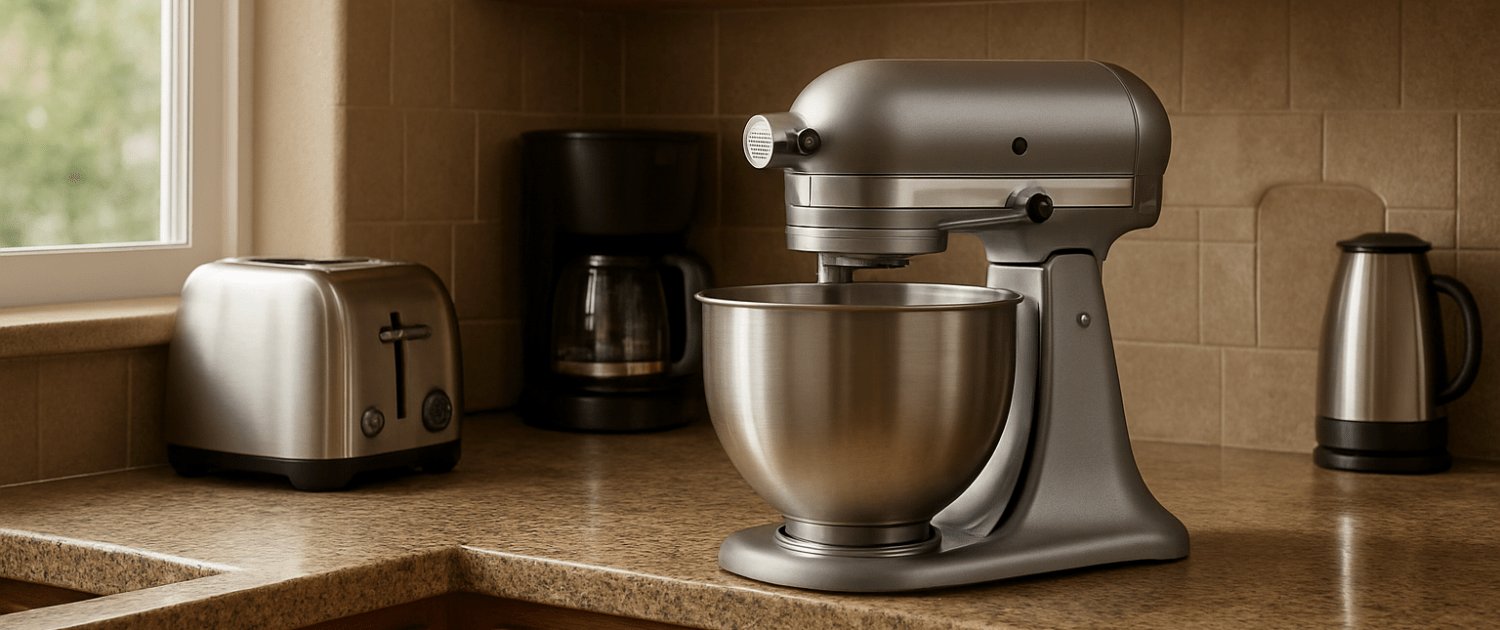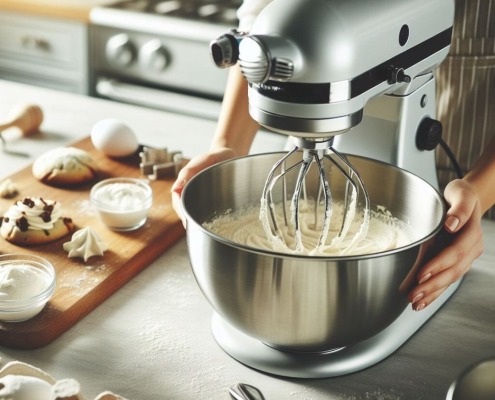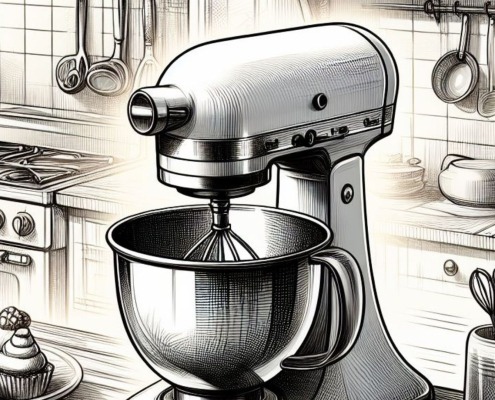KitchenAid Stand Mixer Grinding Noise? Learn What It Means
Steven E / Thursday July 10, 2025
If your KitchenAid stand mixer has started making a loud grinding noise, it can be a little scary, especially when you’re in the middle of a recipe. But don’t worry! That sound usually means something’s going on inside, and it’s an easy fix. Here’s what that grinding noise really means and what you can do about it.
The information in this article may not apply to your specific appliance model. We recommend consulting your manufacturer’s documentation or contact us with any questions.
Why Does a KitchenAid Mixer Make a Grinding Noise?
When everything is working properly, your mixer should produce a steady, smooth hum as it runs. Any noticeable grinding, clunking, or loud metallic sounds mean something inside the gearbox or drive system isn’t quite right.
The most common reasons for grinding include:
- Worn worm gear: KitchenAid mixers use a nylon worm gear that’s designed to wear out (and protect the motor) when the mixer is overloaded.
- Dried-out or insufficient grease: Over time, the grease inside the gearbox can break down, leaving the gears dry and noisy.
- Debris in the gearbox: Small pieces of worn gears or hardened grease can get stuck between moving parts.
- Loose planetary or hub parts: If anything in the drive train becomes loose or misaligned, it can create a grinding sound.
- Cracked or stripped gear teeth: Damage to the internal gears themselves can cause uneven engagement, leading to grinding.
Identifying the exact cause is key to fixing it properly.
What You’ll Need to Fix It
Before you get started, gather these basic tools and supplies:
- Phillips and flathead screwdrivers
- Needle-nose pliers
- Replacement worm gear (if needed)
- Food-safe grease
- Clean rags or shop towels
- Plastic scraper or putty knife
- Small brush or compressed air (for cleaning out debris)
Step 1: Unplug the Mixer and Observe
As soon as you notice a grinding noise, stop using the mixer. Continuing to run it could cause additional damage to the gears.
Unplug it from the outlet and take a moment to consider:
- When does the grinding happen? At all speeds? Only under load?
- Does the mixer still turn the attachments, or is it slipping?
- Are there metal shavings or grease dripping from the head?
These observations will help you pinpoint the likely cause.
Step 2: Open the Mixer Housing
KitchenAid mixers are built to be serviced. To open it up:
- Place the mixer on a clean, dry towel with plenty of workspace.
- Remove the rear cover by unscrewing the two screws.
- Remove the screws on each side of the motor housing and lift off the top cover.
You should now see the internal gears and motor assembly.
Step 3: Inspect the Gearbox
The gearbox is the heart of your mixer’s drive system. Carefully look for:
- Metal shavings or bits of nylon in the grease, a sign of a worn worm gear.
- Grease that’s dark, hard, or separated into oil and solids, an indication it’s past its prime.
- Dry or shiny spots on the gears where grease should be.
- Damaged or missing teeth on any of the gears.
If you see a shredded nylon worm gear, that’s the most common reason for grinding noises, and it’s a relatively easy fix.
Step 4: Clean Out the Old Grease
Whether you’re replacing the worm gear or just repacking grease, you’ll need to clean out the old lubricant.
- Use a scraper or putty knife to remove as much grease as possible.
- Wipe down the gears, housing, and shafts with clean rags.
- Use a brush or compressed air to clear out any debris.
- Make sure all metal surfaces are clean and free of grit before moving on.
Step 5: Replace the Worm Gear (If Needed)
If the worm gear is worn, stripped, or broken, it needs to be replaced.
- Use pliers to remove the retaining clip holding the worm gear in place.
- Slide the damaged gear off the shaft.
- Install the new worm gear, making sure it’s properly aligned with the adjacent gears.
- Replace the retaining clip securely.
The worm gear is made of nylon because it’s meant to fail safely before the motor or other parts do, replacing it restores your mixer’s protection and function.
Step 6: Repack With Fresh Grease
Once everything is clean and repaired:
- Scoop fresh, food-safe grease onto the gears using your fingers or a scraper.
- Pack grease evenly across all gear teeth and moving parts.
- You don’t need to overfill, about 90% coverage is ideal to avoid excess squeeze-out.
Proper lubrication will quiet the gears and keep them running smoothly.
Step 7: Reassemble the Mixer
After greasing:
- Replace the top motor housing and secure it with the screws.
- Replace the rear cover and tighten its screws.
- Wipe down the exterior of the mixer with a clean cloth to remove any fingerprints or smudges.
Step 8: Test the Mixer
Plug the mixer back in and test it at all speeds. If it’s running quietly and smoothly again, you’ve successfully repaired it!
How to Prevent Grinding Noises in the Future
Once your mixer is running like new again, you can keep it that way with a few simple habits:
- Avoid overloading the mixer with too much dough or batter at once.
- Use the recommended speed for each type of task, lower speeds for heavy doughs.
- Repack the gearbox grease every 3–5 years, especially with frequent use.
- Store the mixer in a clean, dry place to prevent moisture damage.
- Periodically check for loose screws or unusual sounds as a sign of wear.
Where To Find Us
If you need any replacement parts for your appliances, you can enter your model number at AppliancePartsPros.com to locate and order them quickly. Most orders arrive in just two business days, and we have tons of great information in our repair help section and YouTube videos to help you troubleshoot.
Stay connected with the latest DIY tips, tutorial videos, and repair guides by following us on Facebook, Instagram, and Twitter. We love hearing about your repair stories and successes. If you need more help or want personalized guidance, feel free to reach out. We’re ready to help you take on your next project with confidence!
With nearly a decade of experience in providing top-notch customer service regarding appliance parts and repair, Steven enjoys sharing practical advice, troubleshooting tips, and interesting information to help readers stay informed.





